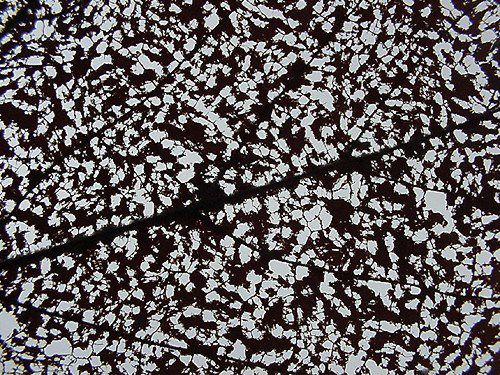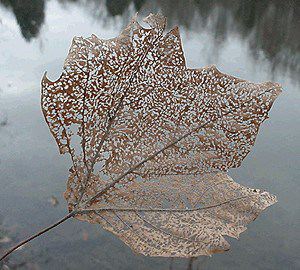|
|
|||
|
THIS WEEK at HILTON POND Installment #---Visitor # (Back to Preceding Week; on to Next Week) |
|
Skeletonized Leaves Now that the cold, short days of December have arrived, nearly all the leaves are gone from most of the trees at Hilton Pond Center. There are a few exceptions, such as the big Southern Red Oak (Quercus falcata) that stands outside the old farmhouse and, of course, all the "evergreen" trees--including Eastern Red Cedar (Juniperus virginiana) and several species of pines (Pinus spp.)--have retained their needles. But, for the most part, the various deciduous trees have lived up to their names as they stand with bare branches against the gray winter sky.  All text & photos © Hilton Pond Center Although most folks enjoy shade that deciduous trees provide in the heat of summer, they lament "having to rake" their leaves each fall. (The phrase "having to rake" is in quotes here because it's not really an obligation. Wouldn't those leaves serve a finer purpose if they were left on the ground where they could decompose and turn into topsoil? But that's another soapbox that we won't climb onto this week . . . .) Rather than spending our time raking, staff at Hilton Pond Center much prefer to examine those leaves when they drop to see if they might tell an interesting story. One of the tales that leaves tell is that all are as different as fingerprints on human hands. The drawing or photo in the field guide of a Southern Red Oak leaf never quite looks exactly like the one growing on the tree; this is one reason that beginning naturalists sometimes have trouble identifying tree species.
Skeletonization can be caused by several factors, but more than likely this sycamore leaf fell victim to a scourge of tiny caterpillars that munched on the tastiest portions of the blade. Leaf veins--pipelines that transport water and food to and from the leaf--are made of cells with with thicker, denser cellulose that would be harder to chew, and these veins are all the caterpillars left behind before moving on to ravage yet another leaf. Fortunately for the sycamore, not every one of its leaves was grazed so thoroughly; otherwise, the tree would have had a pretty tough time carrying out the photosynethisis it needed to survive. All text & photos © Hilton Pond Center |

 Another thing we noticed while shuffling through a carpet of dead leaves this week is that nearly every leaf is "imperfect"--not in the sense that it is asymmetrical (although many are), but because the vast majority of them have a missing edge, a hole, some discoloration, or even an abnormal growth. When we scrutinized one fallen leaf, we knew it came from an American Sycamore (Platanus occidentalis), but only because of its general shape; nearly all the leaf blade was missing, and only the major veins and leaf edging remained. It was, in a sense, a mere skeleton of its original self (see photos).
Another thing we noticed while shuffling through a carpet of dead leaves this week is that nearly every leaf is "imperfect"--not in the sense that it is asymmetrical (although many are), but because the vast majority of them have a missing edge, a hole, some discoloration, or even an abnormal growth. When we scrutinized one fallen leaf, we knew it came from an American Sycamore (Platanus occidentalis), but only because of its general shape; nearly all the leaf blade was missing, and only the major veins and leaf edging remained. It was, in a sense, a mere skeleton of its original self (see photos).